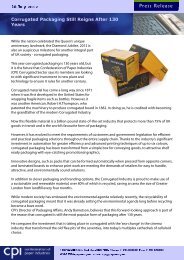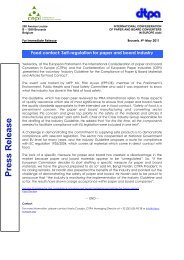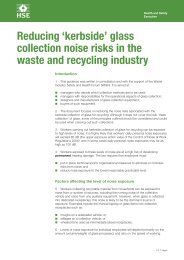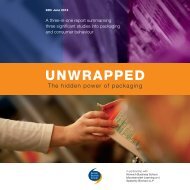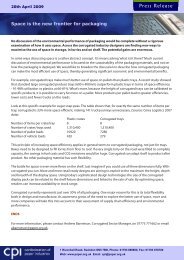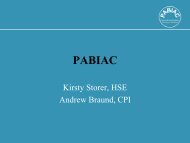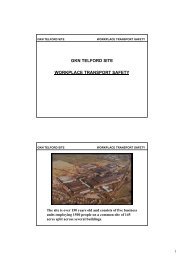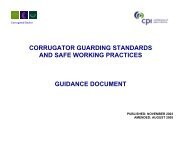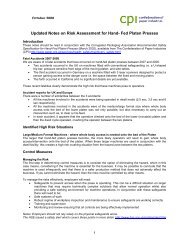The safe use of refuse collection vehicle hoists and bins
The safe use of refuse collection vehicle hoists and bins
The safe use of refuse collection vehicle hoists and bins
Create successful ePaper yourself
Turn your PDF publications into a flip-book with our unique Google optimized e-Paper software.
Health <strong>and</strong> Safety<br />
Executive<br />
<strong>The</strong> <strong>safe</strong> <strong>use</strong> <strong>of</strong> ref<strong>use</strong> <strong>collection</strong><br />
<strong>vehicle</strong> <strong>hoists</strong> <strong>and</strong> <strong>bins</strong><br />
Introduction<br />
1 This ‘best practice’ guidance was written in consultation <strong>and</strong> with the support<br />
<strong>of</strong> the Waste Industry Safety <strong>and</strong> Health Forum (WISH).*<br />
2 It is written for <strong>use</strong>rs, manufacturers <strong>and</strong> suppliers <strong>of</strong> <strong>vehicle</strong> <strong>hoists</strong> <strong>and</strong><br />
wheeled <strong>bins</strong>, for the <strong>collection</strong> <strong>of</strong> domestic <strong>and</strong> trade waste.<br />
3 It does not intend to interpret the law, nor does it aim to be comprehensive, or<br />
imply a preference for any specific waste <strong>collection</strong> system, but contains notes on<br />
good practice which you may find helpful in considering what you need to do. Your<br />
risk assessment may reveal other matters which require attention.<br />
4 It gives examples <strong>of</strong> risks <strong>of</strong> injury to workers <strong>and</strong> members <strong>of</strong> the public, <strong>and</strong><br />
indicates some protective measures <strong>and</strong> <strong>safe</strong> operating procedures that can be<br />
<strong>use</strong>d to minimise these risks. Some short-term solutions to reduce risks from<br />
existing incompatibilities are included in this guidance.<br />
5 <strong>The</strong> industry continues to address incompatibilities <strong>of</strong> design <strong>and</strong> manufacture<br />
between:<br />
■<br />
■<br />
■<br />
<strong>bins</strong>;<br />
<strong>hoists</strong>; <strong>and</strong><br />
the ways in which both are <strong>use</strong>d.<br />
6 Future, longer-term solutions (eg changes to design <strong>and</strong> manufacturing<br />
st<strong>and</strong>ards) will be added to this guidance as they become available.<br />
Application<br />
7 Wheeled ref<strong>use</strong> <strong>collection</strong> <strong>bins</strong> (both domestic ‘wheelie <strong>bins</strong>’ <strong>and</strong> larger-sized<br />
trade waste <strong>bins</strong>) <strong>and</strong> <strong>vehicle</strong>-mounted <strong>hoists</strong> have been in <strong>use</strong> in the UK since the<br />
mid-1980s. Despite technological developments <strong>and</strong> collective experience with this<br />
equipment, significant numbers <strong>of</strong> serious accidents, including deaths, still occur. In<br />
many cases, the underlying ca<strong>use</strong>s have not always been identified, or solutions<br />
effectively applied to minimise the risks.<br />
Common ca<strong>use</strong>s <strong>of</strong> injury<br />
8 <strong>The</strong> most common reports <strong>of</strong> injuries involving wheeled waste <strong>bins</strong> (<strong>of</strong> all sizes)<br />
<strong>and</strong> <strong>vehicle</strong>-mounted <strong>hoists</strong> are:<br />
1 <strong>of</strong> 18 pages
Health <strong>and</strong> Safety<br />
Executive<br />
Waste collector (loader) struck by the waste bin, still attached to the<br />
hoist, as it returns to ground level<br />
Case study: A ref<strong>use</strong> <strong>collection</strong> worker was at the <strong>vehicle</strong>’s side-mounted<br />
control panels when the raised bin lid fell <strong>of</strong>f <strong>and</strong> struck the stop button on<br />
the other side <strong>of</strong> the <strong>vehicle</strong>. As he walked under the raised bin to release<br />
the stop button, his colleague released it from the other side <strong>of</strong> the <strong>vehicle</strong>,<br />
<strong>and</strong> proceeded to lower the hoist. <strong>The</strong> <strong>collection</strong> worker was crushed<br />
between the bin <strong>and</strong> the ground, sustaining injuries as a result.<br />
Waste collector struck by a bin falling from the hoist<br />
Case study: A 1100 litre waste bin fell from a top-loader hoist, killing the<br />
loader. Investigation revealed that, depending on the type <strong>of</strong> waste in the<br />
bin, the full weight <strong>of</strong> the bin may exceed both its own <strong>and</strong> the hoist’s <strong>safe</strong><br />
working load (SWL). Collectors require a simple method to determine if the<br />
total load <strong>of</strong> the bin <strong>and</strong> contents are within SWLs for both the bin <strong>and</strong> hoist.<br />
In addition, any incompatibility between the bin <strong>and</strong> hoist exaggerates the<br />
risk <strong>of</strong> the bin being released during the tipping cycle.<br />
Waste collector becoming entangled in the hoist during the tipping<br />
cycle<br />
Case study: A seasonal <strong>collection</strong> worker was seriously injured when he<br />
was crushed by the hoist as it descended. He may have been attempting to<br />
stop the hopper overflowing by pushing waste back into the hopper while<br />
the bin was tipped. Information, training <strong>and</strong> supervision provided for<br />
seasonal workers should be suitable to ensure <strong>safe</strong> loading.<br />
Case study: A ref<strong>use</strong> <strong>collection</strong> worker was seriously injured when his foot<br />
was crushed in the hoist <strong>of</strong> a ref<strong>use</strong> <strong>collection</strong> <strong>vehicle</strong>. He stood on the hoist<br />
clamp bar so that he could be raised to remove lodged waste that was<br />
preventing the <strong>vehicle</strong> compartment ro<strong>of</strong> from closing. Systems <strong>of</strong> work<br />
were not suitable to ensure that jams in the hopper <strong>and</strong> hoist mechanisms<br />
were cleared <strong>safe</strong>ly. Information, training <strong>and</strong> supervision was insufficient to<br />
ensure that a <strong>safe</strong> system was followed.<br />
Waste collector injured when releasing a waste bin ‘hung up’ on the<br />
hoist, or lost in the back <strong>of</strong> the hopper<br />
Case study: A <strong>collection</strong> worker climbed onto the hoist to remove a waste<br />
bin that had fallen into the hopper when he slipped <strong>and</strong> fell from the back <strong>of</strong><br />
a ref<strong>use</strong> <strong>collection</strong> <strong>vehicle</strong>. Collectors did not have clear instructions not to<br />
climb onto <strong>hoists</strong>, <strong>and</strong> the on-call system was not able to provide back-up<br />
staff to deal <strong>safe</strong>ly with such problems. Monitoring <strong>and</strong> supervision was not<br />
sufficient to ensure <strong>safe</strong> systems <strong>of</strong> work were adhered to.<br />
<strong>The</strong> <strong>safe</strong> <strong>use</strong> <strong>of</strong> ref<strong>use</strong> <strong>collection</strong> <strong>vehicle</strong> <strong>hoists</strong> <strong>and</strong> <strong>bins</strong><br />
2 <strong>of</strong> 18 pages
Health <strong>and</strong> Safety<br />
Executive<br />
9 Other accidents recorded include:<br />
■<br />
■<br />
■<br />
■<br />
collectors injured when moving the waste bin to or from its storage place to the<br />
<strong>vehicle</strong>;<br />
collectors <strong>and</strong> members <strong>of</strong> the public struck by reversing <strong>vehicle</strong>s (see Waste<br />
<strong>and</strong> recycling <strong>vehicle</strong>s in street <strong>collection</strong> 1 );<br />
collectors <strong>and</strong> members <strong>of</strong> the public struck by <strong>vehicle</strong>s moving forwards;<br />
workers injured <strong>and</strong> killed when they fall while riding on the outside <strong>of</strong> a moving<br />
<strong>vehicle</strong>.<br />
Risks<br />
10 A suitable <strong>and</strong> sufficient risk assessment should include all <strong>of</strong> the significant<br />
risks relating to <strong>collection</strong> <strong>of</strong> waste in wheeled waste <strong>bins</strong> (see Appendix 1).<br />
A step-by-step assessment <strong>of</strong> the work carried out by the <strong>collection</strong> team may<br />
identify significant risks arising from:<br />
11 Moving the waste bin:<br />
■<br />
■<br />
■<br />
the manual h<strong>and</strong>ling risks from moving the bin to <strong>and</strong> from its normal storage<br />
area, including the effects <strong>of</strong> size <strong>and</strong> weight <strong>of</strong> the bin;<br />
the effects <strong>of</strong> the surfaces it travels over; <strong>and</strong><br />
the effects <strong>of</strong> design or maintenance <strong>of</strong> the bin <strong>and</strong> its wheels.<br />
12 Use <strong>of</strong> the hoist:<br />
■<br />
■<br />
■<br />
loading onto <strong>and</strong> removing the waste bin from the hoist, including:<br />
- the effects <strong>of</strong> the size <strong>and</strong> weight <strong>of</strong> the bin <strong>and</strong> its contents;<br />
- flexing due to excess weight;<br />
- work organisation, eg the order in which <strong>bins</strong> are loaded onto the hoist;<br />
incompatibilities between the bin <strong>and</strong> the hoist; <strong>and</strong><br />
inadequate maintenance <strong>of</strong> the <strong>bins</strong> <strong>and</strong> <strong>hoists</strong>.<br />
13 Other significant factors, eg human factors:<br />
■<br />
■<br />
■<br />
■<br />
work organisation, eg who operates the hoist controls;<br />
entering the lifting zone while tipping;<br />
shaking the bin with the hoist, to release compacted waste; <strong>and</strong><br />
climbing onto <strong>vehicle</strong>s to release <strong>bins</strong> that have ‘hung up’ on the <strong>vehicle</strong> at the<br />
top <strong>of</strong> the tipping cycle.<br />
Design <strong>and</strong> compatibility <strong>of</strong> equipment<br />
Design <strong>of</strong> waste <strong>bins</strong>, <strong>hoists</strong> <strong>and</strong> <strong>vehicle</strong>s<br />
14 Harmonised European st<strong>and</strong>ards are either available, or are currently being<br />
prepared, to provide guidance on compatibility <strong>of</strong> equipment for designers,<br />
manufacturers <strong>and</strong> suppliers <strong>of</strong> wheeled waste <strong>bins</strong>, <strong>hoists</strong> <strong>and</strong> <strong>vehicle</strong>s. <strong>The</strong>se<br />
include:<br />
<strong>The</strong> <strong>safe</strong> <strong>use</strong> <strong>of</strong> ref<strong>use</strong> <strong>collection</strong> <strong>vehicle</strong> <strong>hoists</strong> <strong>and</strong> <strong>bins</strong><br />
3 <strong>of</strong> 18 pages
Health <strong>and</strong> Safety<br />
Executive<br />
■<br />
■<br />
■<br />
BS EN 1501-1: 1998 2 - guidance on the design <strong>of</strong> <strong>hoists</strong> <strong>and</strong> their attachment<br />
to ref<strong>use</strong> <strong>collection</strong> <strong>vehicle</strong>s;<br />
BS EN 840 Parts 1-6: 2004 3 - guidance on the design <strong>of</strong> waste <strong>bins</strong>;<br />
pr EN 1501-5 4 (a draft) - guidance on the integration <strong>of</strong> the ref<strong>use</strong> <strong>collection</strong><br />
<strong>vehicle</strong> <strong>and</strong> lifting device (hoist), <strong>and</strong> the lifting device <strong>and</strong> designated waste bin.<br />
15 Vehicle manufacturers are continually investigating means (eg the <strong>use</strong> <strong>of</strong><br />
proximity sensing devices) to reduce the risks to workers from waste <strong>bins</strong><br />
descending on the hoist. Until suitable engineering solutions become available,<br />
<strong>use</strong>rs <strong>of</strong> the equipment should institute a suitable system <strong>of</strong> work to minimise the<br />
risk <strong>of</strong> collision between the worker <strong>and</strong> the equipment (see paragraphs 54-56).<br />
Equipment compatibility: matching waste bin <strong>and</strong> hoist<br />
16 When purchasing new <strong>and</strong> replacement equipment, <strong>use</strong>rs should take account<br />
<strong>of</strong> prevailing St<strong>and</strong>ards, <strong>and</strong> ensure that the waste <strong>bins</strong> <strong>and</strong> <strong>hoists</strong> they choose are<br />
fully compatible with each other.<br />
17 This can be achieved, for example, by including specifications:<br />
■<br />
■<br />
in equipment purchasing policies, where the equipment is directly owned;<br />
in service tenders <strong>and</strong> contracts where some or all <strong>of</strong> the waste <strong>collection</strong><br />
service is provided by contractors.<br />
18 Where relevant st<strong>and</strong>ards are specified in tenders <strong>and</strong> contracts, then clients<br />
<strong>and</strong> contractors should ensure that the equipment provided for waste <strong>collection</strong><br />
meets the requirements <strong>of</strong> those St<strong>and</strong>ards.<br />
19 Currently, a number <strong>of</strong> different designs <strong>of</strong> waste <strong>bins</strong> <strong>and</strong> <strong>hoists</strong> are in service.<br />
Although compatible, they may require specific <strong>and</strong> precise adjustments to the<br />
lifting mechanism to ensure that the bin is held in place effectively during the<br />
tipping cycle. Special attention should be paid to the requirements for maintaining<br />
the condition <strong>of</strong> <strong>bins</strong> <strong>and</strong> <strong>hoists</strong>, to ensure that compatibility can be maintained in<br />
<strong>use</strong> (see paragraphs 43-53).<br />
Choosing <strong>hoists</strong> <strong>and</strong> <strong>bins</strong><br />
20 New CE-marked <strong>hoists</strong> <strong>and</strong> <strong>bins</strong> should conform to the requirements <strong>of</strong><br />
BS EN 1501-1: 1998 2 <strong>and</strong> BS EN 840 Parts 1-6: 2004. 3 <strong>The</strong> requirements <strong>of</strong><br />
pr EN 1501-5 4 should also be considered when integrating new or existing<br />
<strong>vehicle</strong>s, <strong>hoists</strong> <strong>and</strong> <strong>bins</strong>. Generic requirements for waste <strong>collection</strong> equipment are<br />
given below, but reference should be made to the relevant St<strong>and</strong>ards for more<br />
detailed information before choosing or modifying equipment.<br />
Hoists<br />
21 <strong>The</strong> hoist should be designed for designated waste <strong>bins</strong> <strong>and</strong> for the maximum<br />
possible load <strong>of</strong> the <strong>bins</strong> chosen (see BS EN 840: 2004 3 ). <strong>The</strong> <strong>safe</strong> working load<br />
(SWL) should be clearly displayed on the <strong>vehicle</strong>, close to the hoist.<br />
22 Monitoring devices (ie devices that detect bin position in the hoist <strong>and</strong> measure<br />
the referenced height <strong>of</strong> the bin) should limit automatic or semi-automatic lifting to<br />
400 mm, if the bin is not correctly located in the hoist.<br />
<strong>The</strong> <strong>safe</strong> <strong>use</strong> <strong>of</strong> ref<strong>use</strong> <strong>collection</strong> <strong>vehicle</strong> <strong>hoists</strong> <strong>and</strong> <strong>bins</strong><br />
4 <strong>of</strong> 18 pages
Health <strong>and</strong> Safety<br />
Executive<br />
23 Automatic or semi-automatic lifting should not be possible without interlocked<br />
barriers in place, to prevent workers entering the movement zone from the sides.<br />
24 <strong>The</strong> peripheral speed <strong>of</strong> the hoist (outermost point when tipping) should not<br />
exceed 2.5 m/s for <strong>bins</strong> with a capacity <strong>of</strong> less than 2500 l, <strong>and</strong> 1.5 m/s for <strong>bins</strong><br />
with a capacity greater than 2500 l, when measured from a st<strong>and</strong>ard point less<br />
than 2500 mm from ground level.<br />
Hoist/<strong>vehicle</strong> interface<br />
25 Where <strong>hoists</strong> <strong>and</strong> hopper compactors can operate simultaneously, there should<br />
be some means <strong>of</strong> preventing a collision between the two.<br />
26 Any crushing or shearing hazards should be eliminated by design <strong>of</strong> the hoist<br />
or, where there is any residual risk, by suitable guarding (see BS EN 349: 1993 5 ).<br />
27 To prevent foot injuries, the distance between ground level <strong>and</strong> the normal<br />
lowest point <strong>of</strong> the hoist should be at least 120 mm. If the hoist needs to be<br />
lowered to ground level, a hold-to-run control should be provided in a position on<br />
the <strong>vehicle</strong> where the hoist is in full view.<br />
Controls<br />
28 Hoist operating controls should be mounted in a <strong>safe</strong> place outside the hoist<br />
<strong>and</strong> bin movement zone.<br />
29 Hoist controls should be protected against accidental operation <strong>and</strong> arranged<br />
so that the operation <strong>of</strong> the controls mimics the direction <strong>of</strong> hoist movement, (eg<br />
the upper button for ‘lift’ <strong>and</strong> the lower button for ‘lower’).<br />
30 <strong>The</strong> hoist should stop when the manual hold-to run control is released.<br />
31 Switching from manual to automatic mode should only be possible with the<br />
hoist in the lowest position <strong>and</strong> should not initiate lifting. Automatic mode should<br />
be cancelled by switching to manual mode.<br />
32 At least two clearly identifiable emergency stop devices should be provided which:<br />
■<br />
■<br />
■<br />
■<br />
■<br />
stop the hoist immediately when <strong>use</strong>d;<br />
are accessible from either side <strong>of</strong> the <strong>vehicle</strong>;<br />
have a clear view <strong>of</strong> the hoisting zone;<br />
have an acoustic signal, which sounds in the driver’s cab when the emergency<br />
stop is activated;<br />
prevent automatic restart without manual resetting.<br />
Hydraulics<br />
33 Hoists should have hose burst protection valves mounted directly on the lifting<br />
rams.<br />
34 All hydraulic hoses <strong>and</strong> fittings should have a <strong>safe</strong>ty factor <strong>of</strong> at least twice the<br />
normal working pressure. Where hoses are located within 500 mm <strong>of</strong> the normal<br />
working area, workers should be shielded from the sudden failure <strong>of</strong> a hose, with<br />
protection that is sufficiently sturdy to stop or divert fluids away.<br />
35 <strong>The</strong> hydraulic power system should comply with the requirements <strong>of</strong><br />
BS EN 982: 1996. 6<br />
<strong>The</strong> <strong>safe</strong> <strong>use</strong> <strong>of</strong> ref<strong>use</strong> <strong>collection</strong> <strong>vehicle</strong> <strong>hoists</strong> <strong>and</strong> <strong>bins</strong><br />
5 <strong>of</strong> 18 pages
Health <strong>and</strong> Safety<br />
Executive<br />
Bins<br />
36 Reference should be made to BS EN 840-6: 2004 Mobile waste <strong>bins</strong> Part 6:<br />
Safety <strong>and</strong> health requirements, 3 when considering:<br />
■<br />
■<br />
■<br />
■<br />
■<br />
■<br />
shape <strong>and</strong> positioning <strong>of</strong> h<strong>and</strong>les;<br />
type <strong>and</strong> positioning <strong>of</strong> wheels;<br />
fitting <strong>of</strong> direction blocks (to assist steering <strong>of</strong> wheels);<br />
type <strong>and</strong> positioning <strong>of</strong> brakes;<br />
type <strong>and</strong> positioning <strong>of</strong> lids;<br />
<strong>and</strong> to manufacturers’ <strong>and</strong> suppliers’ instructions for correct choice, correct<br />
maintenance <strong>and</strong> <strong>safe</strong> <strong>use</strong> <strong>of</strong> <strong>bins</strong>.<br />
37 Those conforming to BS EN 840 Parts 1-63 should have a certificate issued<br />
within six months <strong>of</strong> the date <strong>of</strong> purchase by a known <strong>and</strong> approved test facility.<br />
38 <strong>The</strong>y should be designed <strong>and</strong> built so that, when filled with an appropriate<br />
load, they<br />
■ fit securely into a compatible hoist (BS EN 1501-1: 1998 2 );<br />
■ can be locked into the hoist during the tipping cycle (see pr EN 1501-5 4 ).<br />
39 <strong>The</strong>y should fit <strong>safe</strong>ly onto the hoist without having to be manually carried or<br />
lifted.<br />
40 <strong>The</strong>y should be designed <strong>and</strong> built to minimise the pushing <strong>and</strong> pulling forces<br />
required to move them (BS EN 840-5: 2004 3 ). <strong>The</strong>y should make best <strong>use</strong> <strong>of</strong><br />
shape, size, centre <strong>of</strong> gravity, low rolling resistance <strong>and</strong> likely positioning <strong>of</strong> load,<br />
when positioning wheels <strong>and</strong> h<strong>and</strong>les.<br />
41 Four <strong>and</strong> two-wheeled <strong>bins</strong> should have suitable h<strong>and</strong>les that give workers a<br />
<strong>safe</strong>, two-h<strong>and</strong>ed grip when pushing, pulling <strong>and</strong> manoeuvring them.<br />
42 Sharp edges which could ca<strong>use</strong> injury should be eliminated by design <strong>of</strong> the bin.<br />
Equipment maintenance<br />
43 Regular, routine, scheduled cleaning, lubrication, examination <strong>and</strong> maintenance<br />
schedules are important.<br />
44 Keeping accurate completed service <strong>and</strong> maintenance work records on <strong>hoists</strong><br />
<strong>and</strong> bin stock currently in service permits patterns <strong>of</strong> deterioration, <strong>and</strong> its ca<strong>use</strong>s,<br />
to be established.<br />
45 Routine maintenance regimes can improve <strong>safe</strong>ty <strong>and</strong> reduce business losses by:<br />
■<br />
■<br />
■<br />
identifying faults before catastrophic failure;<br />
permitting repairs before the equipment becomes unserviceable;<br />
identifying incompatibilities or mis<strong>use</strong>, <strong>and</strong> permitting remedial action to be<br />
taken, especially where there are:<br />
- problems with the interface between <strong>hoists</strong> <strong>and</strong> <strong>bins</strong>;<br />
- equipment <strong>use</strong>d in an inappropriate environment;<br />
- ab<strong>use</strong> <strong>of</strong> equipment.<br />
<strong>The</strong> <strong>safe</strong> <strong>use</strong> <strong>of</strong> ref<strong>use</strong> <strong>collection</strong> <strong>vehicle</strong> <strong>hoists</strong> <strong>and</strong> <strong>bins</strong><br />
6 <strong>of</strong> 18 pages
Health <strong>and</strong> Safety<br />
Executive<br />
Hoists<br />
46 To ensure continued <strong>safe</strong> operation <strong>of</strong> the hoist, servicing <strong>and</strong> maintenance<br />
schedules for ref<strong>use</strong> <strong>collection</strong> <strong>vehicle</strong>s should also include planned servicing <strong>and</strong><br />
maintenance <strong>of</strong> the hoist, following the instructions provided by the manufacturer<br />
or supplier.<br />
47 Where faults affecting <strong>safe</strong> <strong>use</strong> <strong>of</strong> the hoist are identified, arrangements should<br />
also be made for prompt reporting, logging <strong>and</strong> timely repair. Written instructions<br />
for staff should include the extent <strong>of</strong> non-specialist preventative maintenance work<br />
which can be carried out as part <strong>of</strong> routine service or repair, <strong>and</strong> agreed work that<br />
should be referred to specialists in hoist maintenance.<br />
48 <strong>The</strong> hoist (including any wire ropes or chains which form part <strong>of</strong> its mechanism)<br />
should also be regularly inspected <strong>and</strong> thoroughly examined by an independent<br />
person competent to carry out the statutory requirements under the Lifting<br />
Operations <strong>and</strong> Lifting Equipment Regulations 19987 (LOLER).<br />
Bins<br />
49 Safe lifting <strong>of</strong> <strong>bins</strong> relies upon effective engagement <strong>of</strong> the bin with the hoist<br />
<strong>and</strong> the structural integrity <strong>of</strong> the bin throughout the emptying cycle.<br />
50 In the absence <strong>of</strong> an effective maintenance regime, bin failures due to wear are<br />
<strong>of</strong>ten only identified when <strong>bins</strong> are inadvertently released from the hoist.<br />
51 Routine planned examination <strong>of</strong> bin stock in service should <strong>use</strong> the<br />
manufacturer or suppliers instructions to identify <strong>bins</strong> which are likely to:<br />
■<br />
■<br />
fail during the emptying cycle, (eg fall from the hoist due to flexing around the<br />
rim <strong>of</strong> the bin);<br />
‘hang-up’ during the emptying cycle (eg when damaged lids catch on the<br />
hoist/<strong>vehicle</strong> structure).<br />
52 Arrangements should be made for prompt reporting <strong>and</strong> replacement <strong>of</strong> <strong>bins</strong><br />
that have been identified as unacceptably worn or faulty.<br />
53 Repairs <strong>and</strong> maintenance to <strong>bins</strong> should <strong>use</strong> parts <strong>and</strong> materials specified in the<br />
manufacturer’s instructions, or exhibit equivalent or superior performance st<strong>and</strong>ards,<br />
<strong>and</strong> be in accordance with the original BS EN 840 Parts 1-6 3 specification.<br />
Safe <strong>use</strong> <strong>of</strong> equipment<br />
54 To address the residual risks from the <strong>use</strong> <strong>of</strong> <strong>bins</strong> <strong>and</strong> <strong>hoists</strong>, <strong>use</strong>rs should<br />
implement suitable <strong>safe</strong> systems <strong>of</strong> work for <strong>collection</strong> teams. <strong>The</strong> systems <strong>of</strong> work<br />
should complement the engineering controls for <strong>safe</strong> <strong>use</strong> <strong>of</strong> <strong>hoists</strong> <strong>and</strong> <strong>bins</strong>, <strong>and</strong><br />
the practical requirements <strong>of</strong> the <strong>collection</strong> round.<br />
55 Written method statements should address:<br />
■<br />
■<br />
manual h<strong>and</strong>ling issues, including <strong>safe</strong> movement <strong>of</strong> waste <strong>bins</strong> (eg over<br />
problematic terrain including kerbs, steps, slopes, cobbles etc);<br />
restrictions, for each type <strong>of</strong> bin <strong>use</strong>d, on the:<br />
- type <strong>of</strong> waste;<br />
- maximum weight;<br />
<strong>The</strong> <strong>safe</strong> <strong>use</strong> <strong>of</strong> ref<strong>use</strong> <strong>collection</strong> <strong>vehicle</strong> <strong>hoists</strong> <strong>and</strong> <strong>bins</strong><br />
7 <strong>of</strong> 18 pages
Health <strong>and</strong> Safety<br />
Executive<br />
■<br />
■<br />
■<br />
■<br />
- amount <strong>of</strong> compaction;<br />
situations where the bin should not be presented for tipping, (eg unacceptable<br />
contents or overfull);<br />
- situations under which it is (or is not) appropriate to <strong>use</strong> manual, semiautomatic<br />
<strong>and</strong> automatic tipping modes;<br />
work sequences for placing <strong>bins</strong> onto <strong>hoists</strong> eg:<br />
- both <strong>bins</strong> taken <strong>of</strong>f a dual-lift hoist before another bin is put on; <strong>and</strong><br />
- agreement on which worker takes responsibility for selecting manual, semiautomatic<br />
<strong>and</strong> automatic modes <strong>and</strong> operating the controls;<br />
<strong>safe</strong> st<strong>and</strong>ing positions for workers during the tipping cycle including<br />
information on the risk zones eg:<br />
- the lifting arc <strong>of</strong> the hoist;<br />
- under the bin;<br />
- when it is in the raised position etc;<br />
<strong>safe</strong> bin retrieval arrangements, including:<br />
- <strong>bins</strong> ‘hung up’ on the top <strong>of</strong> the <strong>vehicle</strong> (eliminating the need to climb on the<br />
<strong>vehicle</strong>); <strong>and</strong><br />
- <strong>bins</strong> fallen into the hopper.<br />
56 <strong>The</strong>se arrangements may include, for example, provision <strong>of</strong> portable unhooking<br />
devices <strong>and</strong> <strong>safe</strong> systems <strong>of</strong> work, specialist back-up support arrangements for<br />
crew etc).<br />
Information, instruction, training, supervision<br />
<strong>and</strong> staff consultation<br />
57 <strong>The</strong> Provision <strong>and</strong> Use <strong>of</strong> Work Equipment Regulations 19988 (PUWER) place<br />
requirements on employers to ensure that adequate information, instructions <strong>and</strong> training<br />
are provided for waste <strong>collection</strong> teams, maintenance teams, <strong>and</strong> their supervisors <strong>and</strong><br />
managers (see regulation 8: Information <strong>and</strong> instructions <strong>and</strong> regulation 9: Training).<br />
58 Clear information, operating instructions <strong>and</strong> training should be provided for all<br />
crews <strong>and</strong> maintenance teams working with <strong>bins</strong> <strong>and</strong> <strong>hoists</strong>. This should supplement<br />
other training provided to reduce the wider risks from waste <strong>collection</strong> activities.<br />
59 Suitable training may include cascade training from manufacturers <strong>and</strong><br />
suppliers <strong>of</strong> <strong>bins</strong> <strong>and</strong> <strong>hoists</strong>, schemes for <strong>safe</strong>ty certification <strong>of</strong> <strong>collection</strong> teams, or<br />
<strong>use</strong>r’s in-ho<strong>use</strong> non-statutory competence or passport training schemes. Effective<br />
training for each individual should include all relevant risks <strong>and</strong> preventative<br />
measures for their work<br />
60 Examples where written method statements <strong>and</strong>/or training need to be given<br />
include, but are not restricted to:<br />
■<br />
■<br />
■<br />
■<br />
<strong>safe</strong> systems for crews on manual h<strong>and</strong>ling <strong>of</strong> receptacles <strong>and</strong> <strong>use</strong> <strong>of</strong> <strong>hoists</strong>;<br />
<strong>safe</strong> systems for maintenance access to <strong>hoists</strong> for maintenance teams;<br />
instructions for the lone worker at the rear <strong>of</strong> the <strong>vehicle</strong> staffed by a two-man<br />
team;<br />
instructions for crews or maintenance staff on when to refer hoist problems for<br />
further advice.<br />
61 Refresher training arrangements should also be considered for both<br />
experienced <strong>and</strong> newer workers, with the opportunity to discuss issues <strong>and</strong><br />
provide solutions to problems.<br />
<strong>The</strong> <strong>safe</strong> <strong>use</strong> <strong>of</strong> ref<strong>use</strong> <strong>collection</strong> <strong>vehicle</strong> <strong>hoists</strong> <strong>and</strong> <strong>bins</strong><br />
8 <strong>of</strong> 18 pages
Health <strong>and</strong> Safety<br />
Executive<br />
62 <strong>The</strong>re is also an obligation upon managers to consult with staff on health <strong>and</strong><br />
<strong>safe</strong>ty issues, especially if there are changes in plant or procedures (see Consulting<br />
employees on health <strong>and</strong> <strong>safe</strong>ty: A guide to the law 9 ). <strong>The</strong> contribution <strong>of</strong> all staff<br />
is essential to <strong>safe</strong> working <strong>and</strong> it is important that <strong>safe</strong>ty representatives <strong>and</strong> other<br />
staff are supported to raise or maintain their level <strong>of</strong> competence to carry out their<br />
duties <strong>safe</strong>ly <strong>and</strong> effectively.<br />
63 <strong>The</strong>y can contribute positively in achieving the desired outcomes by:<br />
■<br />
■<br />
■<br />
identifying problems;<br />
indicating whether activities can be carried out <strong>safe</strong>ly under prevailing<br />
conditions;<br />
generating sound practical ideas <strong>and</strong> solutions.<br />
64 Information <strong>and</strong> training for supervisors should include arrangements for<br />
ensuring that the information, instruction <strong>and</strong> training have been fully understood,<br />
taken on by staff <strong>and</strong> continues to be <strong>use</strong>d. Specific training should be considered<br />
for supervisors on how to provide support for <strong>collection</strong> teams, when a full bin has<br />
to be ‘ref<strong>use</strong>d’ for tipping, beca<strong>use</strong> the contents are unacceptable.<br />
<strong>The</strong> <strong>safe</strong> <strong>use</strong> <strong>of</strong> ref<strong>use</strong> <strong>collection</strong> <strong>vehicle</strong> <strong>hoists</strong> <strong>and</strong> <strong>bins</strong><br />
9 <strong>of</strong> 18 pages
Health <strong>and</strong> Safety<br />
Executive<br />
Appendix 1<br />
Risk assessment<br />
IMPORTANT<br />
This appendix is only a guide. Depending upon your individual activities <strong>and</strong><br />
organisation’s policies, you may need to delete, alter, amend or supplement the<br />
contents when devising your own documentation<br />
Type <strong>and</strong> plant/ref no.<br />
Name <strong>of</strong> assessor/date <strong>of</strong> assessment<br />
General description <strong>of</strong> equipment (<strong>vehicle</strong>, hoist <strong>and</strong> waste bin(s)).<br />
Intended function <strong>of</strong> equipment <strong>and</strong> suitability for function<br />
<strong>The</strong> <strong>safe</strong> <strong>use</strong> <strong>of</strong> ref<strong>use</strong> <strong>collection</strong> <strong>vehicle</strong> <strong>hoists</strong> <strong>and</strong> <strong>bins</strong><br />
10 <strong>of</strong> 18 pages
Health <strong>and</strong> Safety<br />
Executive<br />
Preventing access to dangerous areas<br />
■<br />
■<br />
Is access possible to any equipment that could injure, particularly around the<br />
hoist mechanism?<br />
What access is needed during normal operation <strong>of</strong> the equipment?<br />
Equipment Location Who is at risk? Potential injury<br />
■<br />
■<br />
For the equipment identified above, what method <strong>of</strong> protection will be necessary?<br />
Will this be suitable taking into account the operation <strong>of</strong> the equipment?<br />
Equipment<br />
Fixed/other<br />
guard<br />
Other protective<br />
measures – eg:<br />
hold-to-run<br />
devices<br />
Systems <strong>of</strong> work<br />
■<br />
■<br />
Where protective measures are provided, are they effective?<br />
Will they prevent risks from inadvertent operation when more than worker is<br />
working with the equipment?<br />
Protective devices/systems<br />
Effective? Eg:<br />
■ <strong>of</strong> sound construction;<br />
■ not easily by-passed/disabled;<br />
■ adequately distant from danger but<br />
allowing a good view <strong>of</strong> the<br />
process where necessary;<br />
■ maintenance access only etc?<br />
<strong>The</strong> <strong>safe</strong> <strong>use</strong> <strong>of</strong> ref<strong>use</strong> <strong>collection</strong> <strong>vehicle</strong> <strong>hoists</strong> <strong>and</strong> <strong>bins</strong><br />
11 <strong>of</strong> 18 pages
Health <strong>and</strong> Safety<br />
Executive<br />
Maintaining protective measures<br />
■<br />
■<br />
What maintenance is necessary for the equipment <strong>and</strong> protective devices?<br />
What preventative maintenance is required for <strong>safe</strong>ty-related parts <strong>of</strong> the<br />
system?<br />
Protective<br />
devices/systems<br />
Maintenance Frequency Responsible<br />
person<br />
Information, instruction <strong>and</strong> training<br />
What information should be provided<br />
to workers <strong>and</strong> others working with<br />
that equipment?<br />
Who is responsible for providing that<br />
information?<br />
What instruction <strong>and</strong> training must be provided to the<br />
following?<br />
Workers Maintenance staff Supervisors<br />
<strong>The</strong> <strong>safe</strong> <strong>use</strong> <strong>of</strong> ref<strong>use</strong> <strong>collection</strong> <strong>vehicle</strong> <strong>hoists</strong> <strong>and</strong> <strong>bins</strong><br />
12 <strong>of</strong> 18 pages
Health <strong>and</strong> Safety<br />
Executive<br />
Who is responsible for providing instruction <strong>and</strong> training to the<br />
following?<br />
Workers Maintenance staff Supervisors<br />
Assessor details:<br />
Name ..............................................................................<br />
Position ..............................................................................<br />
Date ..............................................................................<br />
<strong>The</strong> <strong>safe</strong> <strong>use</strong> <strong>of</strong> ref<strong>use</strong> <strong>collection</strong> <strong>vehicle</strong> <strong>hoists</strong> <strong>and</strong> <strong>bins</strong><br />
13 <strong>of</strong> 18 pages
Health <strong>and</strong> Safety<br />
Executive<br />
Appendix 2<br />
Collection team/supervisor checklist<br />
1. Risk assessment/method statements for operation seen <strong>and</strong> understood.<br />
2. Vehicle <strong>and</strong> hoist in <strong>safe</strong> operational condition, including records <strong>of</strong> remedial<br />
work in response to fault reports (visual/functional inspection before leaving depot).<br />
3. Ancillary equipment stored on <strong>vehicle</strong> (eg pole to release bin ‘hang–ups’).<br />
4. Team members undertaken suitable induction <strong>and</strong> operational training for this<br />
operation (operation <strong>of</strong> equipment, manual h<strong>and</strong>ling <strong>of</strong> <strong>bins</strong>, <strong>and</strong> h<strong>and</strong>ling <strong>of</strong><br />
public/clients, when <strong>bins</strong> not taken for emptying).<br />
5. Access/surface checked before bin moved; if arrangements for movement<br />
unsuitable (eg poor surface or further equipment required), bin left <strong>and</strong> reported to<br />
management, for suitable arrangements to be made.<br />
6. Contents/condition <strong>of</strong> bin checked before presenting to hoist. If<br />
contents/condition <strong>of</strong> bin unsuitable to lift, bin left <strong>and</strong> reported to management, for<br />
suitable arrangements to be made.<br />
7. Minor faults on <strong>vehicle</strong>, hoist <strong>and</strong> bin recorded, for report to<br />
management/maintenance crew on return to depot at end <strong>of</strong> shift.<br />
8. Significant faults, eg with hoist operation <strong>and</strong> ‘hung-ups’ which require<br />
maintenance intervention, reported to management/maintenance as occur.<br />
Additional risk to <strong>collection</strong> team assessed, <strong>and</strong> risk-related decision made whether<br />
<strong>vehicle</strong> attended should be attended by maintenance crew or returned to depot for<br />
remedial work.<br />
9. Minor faults on <strong>vehicle</strong>, hoist <strong>and</strong> bin reported to management/maintenance<br />
crew on return to depot.<br />
10. Completed team check sheet returned to supervisor, for review.<br />
<strong>The</strong> <strong>safe</strong> <strong>use</strong> <strong>of</strong> ref<strong>use</strong> <strong>collection</strong> <strong>vehicle</strong> <strong>hoists</strong> <strong>and</strong> <strong>bins</strong><br />
14 <strong>of</strong> 18 pages
Health <strong>and</strong> Safety<br />
Executive<br />
Appendix 3<br />
Supervisor checklist<br />
1. Risk assessment/method statements for operation seen <strong>and</strong> understood by<br />
<strong>collection</strong> team.<br />
2. Team members undertaken suitable induction <strong>and</strong> operational training for this<br />
operation (operation <strong>of</strong> equipment, manual h<strong>and</strong>ling <strong>of</strong> <strong>bins</strong>, <strong>and</strong> h<strong>and</strong>ling <strong>of</strong><br />
public/clients, when <strong>bins</strong> not taken for emptying).<br />
3. Significant faults, eg with hoist operation, <strong>and</strong> ‘hung-ups’ which require<br />
maintenance intervention reported to management/maintenance as they occur,<br />
additional risk to <strong>collection</strong> team assessed, <strong>and</strong> risk-related decision made whether<br />
<strong>vehicle</strong> attended should be attended by maintenance crew or returned to depot for<br />
remedial work.<br />
4. Minor faults on <strong>vehicle</strong>, hoist <strong>and</strong> bin reported to management/maintenance<br />
crew on return to depot.<br />
5. Completed team check sheet returned to supervisor for review.<br />
References<br />
1 Waste <strong>and</strong> recycling <strong>vehicle</strong>s in street <strong>collection</strong> Leaflet Web14 HSE 2005<br />
Web-only version available at www.hse.gov.uk/pubns/web14.pdf<br />
2 BS EN 1501-1: 1998 Ref<strong>use</strong> <strong>collection</strong> <strong>vehicle</strong>s <strong>and</strong> their associated lifting<br />
devices. General requirements <strong>and</strong> <strong>safe</strong>ty requirements. Rear-end loaded ref<strong>use</strong><br />
<strong>collection</strong> <strong>vehicle</strong>s British St<strong>and</strong>ards Institution ISBN 0 580 30172 9<br />
3 BS EN 840-1: 2004 Mobile waste containers. Containers with 2 wheels with<br />
a capacity up to 400 l for comb lifting devices, dimensions <strong>and</strong> design British<br />
St<strong>and</strong>ards Institution ISBN 0 580 43566 0<br />
BS EN 840-2: 2004 Mobile waste containers. Containers with 4 wheels with<br />
capacity up to 1300 l with flat lid(s), for trunnion <strong>and</strong>/or comb lifting devices.<br />
Dimensions <strong>and</strong> design British St<strong>and</strong>ards Institution ISBN 0 580 43568 7<br />
BS EN 840-3: 2004 Mobile waste containers. Containers with 4 wheels with<br />
capacity up to 1300 l with dome lid(s), for trunnion <strong>and</strong>/or comb lifting devices.<br />
Dimensions <strong>and</strong> design British St<strong>and</strong>ards Institution ISBN 0 580 43567 9<br />
BS EN 840-4: 2004 Mobile waste containers. Containers with 4 wheels with<br />
capacity up to 1700 l with flat lid(s), for wide trunnion or BG- <strong>and</strong>/or wide comb<br />
lifting devices. Dimensions <strong>and</strong> design British St<strong>and</strong>ards Institution ISBN 0 580<br />
43569 5<br />
BS EN 840-5: 2004 Mobile waste containers. Performance requirements <strong>and</strong><br />
test methods British St<strong>and</strong>ards Institution ISBN 0 580 43570 9<br />
BS EN 840-6: 2004 Mobile waste containers. Safety <strong>and</strong> health requirements<br />
British St<strong>and</strong>ards Institution ISBN 0 580 43565 2<br />
<strong>The</strong> <strong>safe</strong> <strong>use</strong> <strong>of</strong> ref<strong>use</strong> <strong>collection</strong> <strong>vehicle</strong> <strong>hoists</strong> <strong>and</strong> <strong>bins</strong><br />
15 <strong>of</strong> 18 pages
Health <strong>and</strong> Safety<br />
Executive<br />
4 pr EN 1501-5 Ref<strong>use</strong> <strong>collection</strong> <strong>vehicle</strong>s; integration <strong>of</strong> <strong>vehicle</strong>s, lifting<br />
devices <strong>and</strong> waste <strong>bins</strong> (A pr EN is not a publicly available document. A European<br />
committee is currently drafting this St<strong>and</strong>ard.)<br />
5 BS EN 349: 1993 Safety <strong>of</strong> machinery. Minimum gaps to avoid crushing <strong>of</strong><br />
parts <strong>of</strong> the human body British St<strong>and</strong>ards Institution ISBN 0 580 21394 3<br />
6 BS EN 982: 1996 Safety <strong>of</strong> machinery. Safety requirements for fluid power<br />
systems <strong>and</strong> their components. Hydraulics British St<strong>and</strong>ards Institution<br />
ISBN 0 580 26257 X<br />
7 Lifting Operations <strong>and</strong> Lifting Equipment Regulations 1998 SI 1998/2307 <strong>The</strong><br />
Stationery Office 1998 ISBN 0 11 079598 9<br />
8 Provision <strong>and</strong> Use <strong>of</strong> Work Equipment Regulations 1998 SI 1998/2306 <strong>The</strong><br />
Stationery Office 1998 ISBN 0 11 079599 7<br />
9 Consulting employees on health <strong>and</strong> <strong>safe</strong>ty: A guide to the law Leaflet<br />
INDG232 HSE Books 1996 (single copy free or priced packs <strong>of</strong> 15<br />
ISBN 0 7176 1615 0) Web version: www.hse.gov.uk/pubns/indg232.pdf<br />
Further reading<br />
Management <strong>of</strong> health <strong>and</strong> <strong>safe</strong>ty at work. Management <strong>of</strong> Health <strong>and</strong> Safety at<br />
Work Regulations 1999. Approved Code <strong>of</strong> Practice <strong>and</strong> guidance L21 (Second<br />
edition) HSE Books 2000 ISBN 0 7176 2488 9<br />
Safe <strong>use</strong> <strong>of</strong> work equipment. Provision <strong>and</strong> Use <strong>of</strong> Work Equipment Regulations<br />
1998. Approved Code <strong>of</strong> Practice <strong>and</strong> guidance L22 (Second edition) HSE Books<br />
1998 ISBN 0 7176 1626 6<br />
Manual h<strong>and</strong>ling. Manual H<strong>and</strong>ling Operations Regulations 1992 (as amended).<br />
Guidance on Regulations L23 (Third edition) HSE Books 2004 ISBN 0 7176 2823 X<br />
Safe <strong>use</strong> <strong>of</strong> lifting equipment. Lifting Operations <strong>and</strong> Lifting Equipment<br />
Regulations 1998. Approved Code <strong>of</strong> Practice <strong>and</strong> guidance L113 HSE Books<br />
1998 ISBN 0 7176 1628 2<br />
Using work equipment <strong>safe</strong>ly Leaflet INDG229(rev1) HSE Books 2002 (single copy<br />
free or priced packs <strong>of</strong> 10 ISBN 0 7176 2389 0) Web version:<br />
www.hse.gov.uk/pubns/indg229.pdf<br />
Supplying new machinery: A short guide to the law <strong>and</strong> some information on<br />
what to do for anyone supplying machinery for <strong>use</strong> at work Leaflet INDG270 HSE<br />
Books 1998 (single copy free or priced packs <strong>of</strong> 15 ISBN 0 7176 1560 X) Web<br />
version: www.hse.gov.uk/pubns/indg270.htm<br />
Buying new machinery: A short guide to the law <strong>and</strong> some information on what<br />
to do for anyone buying new machinery for <strong>use</strong> at work Leaflet INDG271 HSE<br />
Books 1998 (single copy free or priced packs <strong>of</strong> 15 ISBN 0 7176 1559 6) Web<br />
version: www.hse.gov.uk/pubns/indg271.htm<br />
Simple guide to the Provision <strong>and</strong> Use <strong>of</strong> Work Equipment Regulations 1998<br />
Leaflet INDG291 HSE Books 1999 (single copy free or priced packs <strong>of</strong> 15<br />
ISBN 0 7176 2429 3) Web version: www.hse.gov.uk/pubns/indg291.pdf<br />
<strong>The</strong> <strong>safe</strong> <strong>use</strong> <strong>of</strong> ref<strong>use</strong> <strong>collection</strong> <strong>vehicle</strong> <strong>hoists</strong> <strong>and</strong> <strong>bins</strong><br />
16 <strong>of</strong> 18 pages
Health <strong>and</strong> Safety<br />
Executive<br />
Note<br />
*<strong>The</strong> Waste Industry Safety <strong>and</strong> Health (WISH) forum exists to communicate <strong>and</strong><br />
consult with key stakeholders, including local <strong>and</strong> national government bodies,<br />
equipment manufacturers, trade associations, pr<strong>of</strong>essional associations <strong>and</strong> trades<br />
unions. <strong>The</strong> aim <strong>of</strong> WISH is to identify, devise <strong>and</strong> promote activities which can<br />
improve industry health <strong>and</strong> <strong>safe</strong>ty st<strong>and</strong>ards.<br />
Further information<br />
HSE priced <strong>and</strong> free publications are available by mail order from HSE Books,<br />
PO Box 1999, Sudbury, Suffolk CO10 2WA Tel: 01787 881165 Fax: 01787 313995<br />
Website: www.hsebooks.co.uk (HSE priced publications are also available from<br />
bookshops <strong>and</strong> free leaflets can be downloaded from HSE’s website:<br />
www.hse.gov.uk.)<br />
For information about health <strong>and</strong> <strong>safe</strong>ty ring HSE's Infoline Tel: 0845 345 0055<br />
Fax: 0845 408 9566 Textphone: 0845 408 9577 e-mail: hse.infoline@natbrit.com or<br />
write to HSE Information Services, Caerphilly Business Park, Caerphilly CF83 3GG.<br />
British St<strong>and</strong>ards are available from BSI Customer Services, 389 Chiswick High Road,<br />
London W4 4AL Tel: 020 8996 9001 Fax: 020 8996 7001 e-mail: cservices@bsiglobal.com<br />
Website: www.bsi-global.com<br />
<strong>The</strong> Stationery Office publications are available from <strong>The</strong> Stationery Office, PO Box 29,<br />
Norwich NR3 1GN Tel: 0870 600 5522 Fax: 0870 600 5533<br />
e-mail: customer.services@tso.co.uk<br />
Website: www.tso.co.uk (<strong>The</strong>y are also available from bookshops.)<br />
This document contains notes on good practice which are not compulsory<br />
but which you may find helpful in considering what you need to do.<br />
This document is available web-only at: www.hse.gov.uk/pubns/web17.pdf<br />
© Crown copyright This publication may be freely reproduced, except for<br />
advertising, endorsement or commercial purposes. First published 08/06. Please<br />
acknowledge the source as HSE.<br />
<strong>The</strong> <strong>safe</strong> <strong>use</strong> <strong>of</strong> ref<strong>use</strong> <strong>collection</strong> <strong>vehicle</strong> <strong>hoists</strong> <strong>and</strong> <strong>bins</strong><br />
17 <strong>of</strong> 18 pages
Health <strong>and</strong> Safety<br />
Executive<br />
This document has been agreed as representing best practice by the Waste<br />
Industry Health <strong>and</strong> Safety (WISH) forum. It is one <strong>of</strong> a planned series <strong>of</strong> ‘best<br />
practice’ advisory documents for the waste management <strong>and</strong> recycling industries,<br />
<strong>and</strong> will be reviewed periodically. Suggestions for improvements should be directed<br />
to Jan Willets (jan.willets@hse.gsi.gov.uk) or Trevor Hay (trevor.hay@hse.gsi.gov.uk).<br />
Published by the Health <strong>and</strong> Safety Executive Ref no. WEB17 08/06<br />
18 <strong>of</strong> 18 pages



